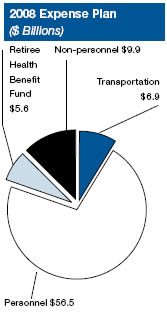II. INCREASE EFFICIENCY
The Postal Service continues its commitment to reduce costs by $1 billion each year. The new postal law places a limit on price increases at the CPI for all mailing services, which comprise 90 percent of postal revenues. The cap means that price increases cannot sufficiently cover costs if overall postal expenses increase above the rate of inflation. The Postal Service has limited control over some growing expenses, such as the price of fuel and employee benefits inflation. The law also requires that the health benefits of future retirees be funded by 2017. The cost for this change alone is $5.6 billion in 2008.

To succeed in this new environment, the Postal Service must continue to increase efficiency and drive down costs in all operations and processes. Strategies pursued to date have been very effective, producing eight straight years of productivity growth and more than $7.5 billion in savings since 2002. Further process improvement gains can be achieved in virtually all areas. New tools, technologies, and unprecedented levels of information are identifying opportunities to reengineer processes that add little value.
Improvements in efficiency go hand in hand with improvements in service quality. The same Intelligent Mail data that are helping flag missorted mail are also identifying mail that should be processed by automation but instead is being handled manually. Similarly, steps to streamline business mail entry by reducing paper documentation will add convenience at acceptance, reduce administrative costs, and improve data exchange. The enormous potential of Intelligent Mail lies in its capacity to identify areas to improve efficiency at all points in the system, starting with the quality of addresses and mailing lists, up to the capture and correction of sortation errors at the point of delivery.
Roughly one-third of the $1 billion savings planned for 2008 will come from investments in enhanced equipment and systems. The Postal Service will continue to focus on automating as much of the mail stream as possible, especially by increasing the amount of mail sequenced in the order of delivery. Notwithstanding steady advances in automation, labor still represents 79 percent of postal operating costs. Workforce planning is a top priority, and the Postal Service is redoubling efforts to anticipate and match workload with the most efficient staffing. Here, too, information is key.
The remaining two-thirds of planned savings will come from process improvements. Most letter operations have been successfully automated; however, 40 percent of flat mail is still processed manually. Deployment of the Flats Sequencing System (FSS), starting in 2008, promises to bring efficiency gains to flat mail similar to those achieved by sequencing letters. Increased standardization will support the capture of savings from FSS and from multiple other initiatives. The use of continuous improvement strategies and Lean Six Sigma tools, along with increasing amounts of actionable data, will help increase equipment utilization and streamline support processes.
Broader use of leading supply chain practices will continue to improve the quality and timeliness of purchased goods and services while helping the Postal Service get more value for its money.
To remain competitive the Postal Service must become more efficient across all operations. That was true before passage of the new law. The price cap only put that imperative into sharper focus. The law strongly endorses continuing efforts to adapt the postal network in conjunction with changes in mail volume. However, the law does not alter the Postal Service‘s basic cost structure. Nor does it provide any new labor flexibility. Recent productivity achievements were the result of disciplined field management, improved visibility on costs, and better information flows with mailers and business partners to improve quality, control complement planning, and optimize mail preparation. These approaches will continue to drive efficiency in the years ahead.

